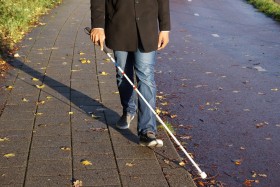Making Your Home Safer for Those With Impaired Vision

In personal injury law, one concept that frequently comes up is the idea of hazards being “open and obvious.” If someone is injured on property owned/maintained by someone else, the person responsible for maintaining the property might try to argue that they shouldn’t be legally liable for the injury because the hazard was so obvious that the victim should have reasonably known to avoid it. Most commonly, this comes up in slip, trip, and fall accidents.
However, it’s very important to remember that not everybody has 20/20 vision. Blindness and vision loss are some of the most common types of disabilities, impacting millions of people in the United States. What might seem like an “open and obvious” hazard to some people might not be so obvious for a person who is blind or has impaired vision.
Businesses have a responsibility to design their businesses in line with ADA guidelines to make sure their properties are accessible and safe for customers with disabilities. But if you know someone who is blind or has impaired vision will be visiting your home, it’s also important for you to make sure there aren’t any hazards that could lead to a serious injury. Making your home safer for those with impaired vision doesn’t necessarily have to mean making drastic changes to your home. Some of the most effective things you can do help those with impaired vision are simple and very inexpensive. In fact, they can help make your home a safer place to visit for users of all abilities.
Remove Slip & Trip Hazards
One of the best things you can do to make your home safe for visitors with all levels of eyesight is get rid of as many potential slip and trip hazards as possible, both inside and outside of your home. This can include making sure the concrete in your driveway and sidewalks are even and unbroken, making sure the hose is put away, taping down edges of rugs, making sure electrical cords are kept out of areas where people walk, and keeping clutter out of hallways and stairways.
Boost Your Lighting
Vision loss occurs in varying degrees. Some people experience a total loss of eyesight, but it’s more common to have low vision. With low vision, people may need extra light to help get around and safely go about their lives. In staircases, for example, you might want to consider switching out your light bulbs for ones with a higher wattage. Or, if possible, you could open your blinds and curtains to maximize the natural light in your home. However, if you do that, it’s important to make sure the sunlight isn’t creating glare, which can also cause problems for people with low vision.
Check Your Handrails
If you have any stairs in your house or leading up to your home, make sure the handrails are in good shape and are firmly secured. If handrails have become loose, they can fail right when they’re needed the most. People of all abilities rely on handrails to help them get up and down stairs safely, so it’s not hard to imagine how vital they are for people with impaired vision.
Slip, trip, and fall accidents can potentially cause very serious injuries that have significant long-term effects, such as brain injuries, broken bones, and spinal cord injuries. If you’ve been injured while on property owned/maintained by someone else, it’s extremely important to get in touch with a slip and fall lawyer who can help make sure you receive all the compensation you need. At Goodwin & Scieszka, we’ve helped many Michigan slip, trip, and fall accident victims just like you. Contact us today to get started.
Image: iStock / Dafinchi






